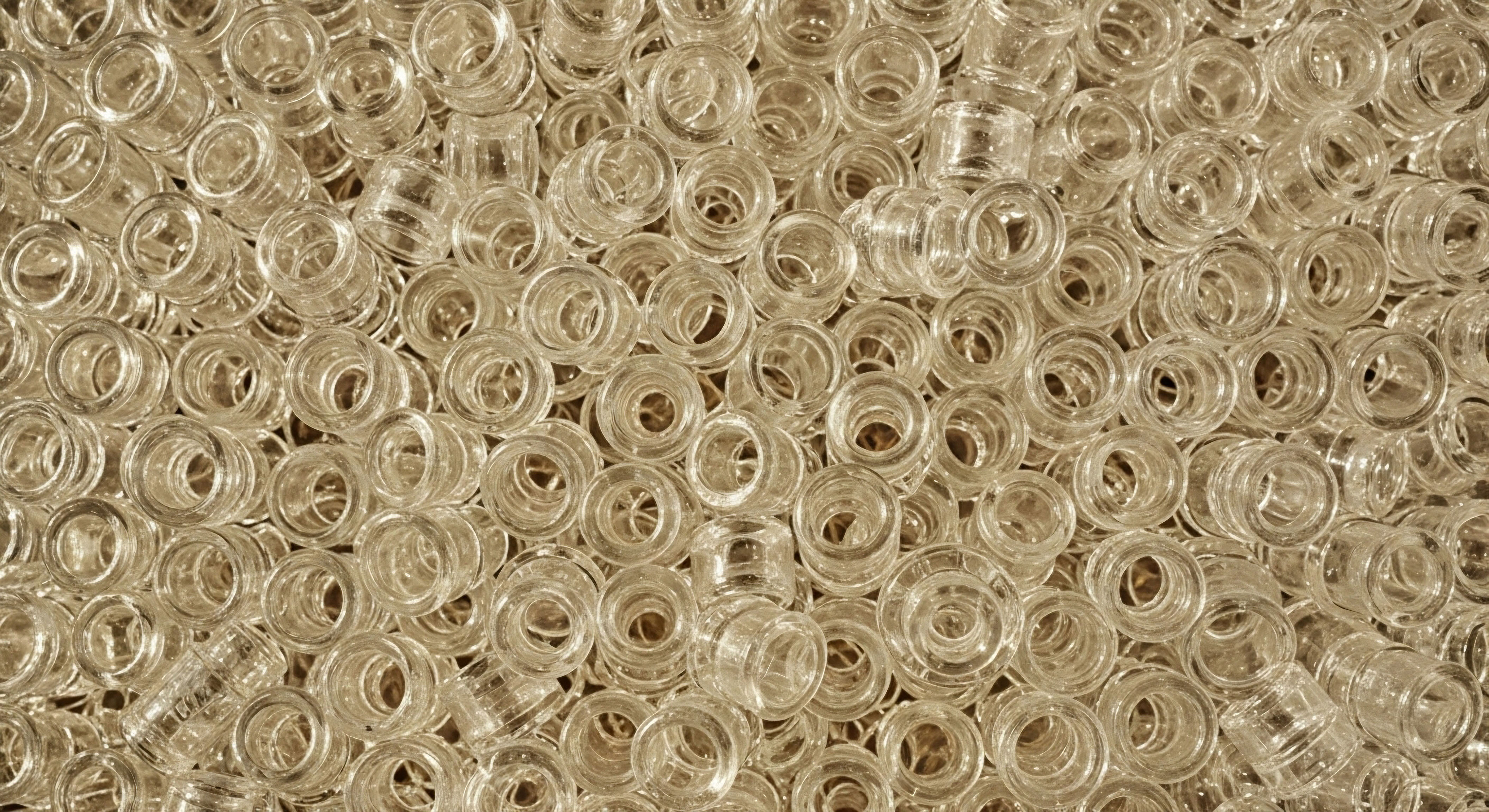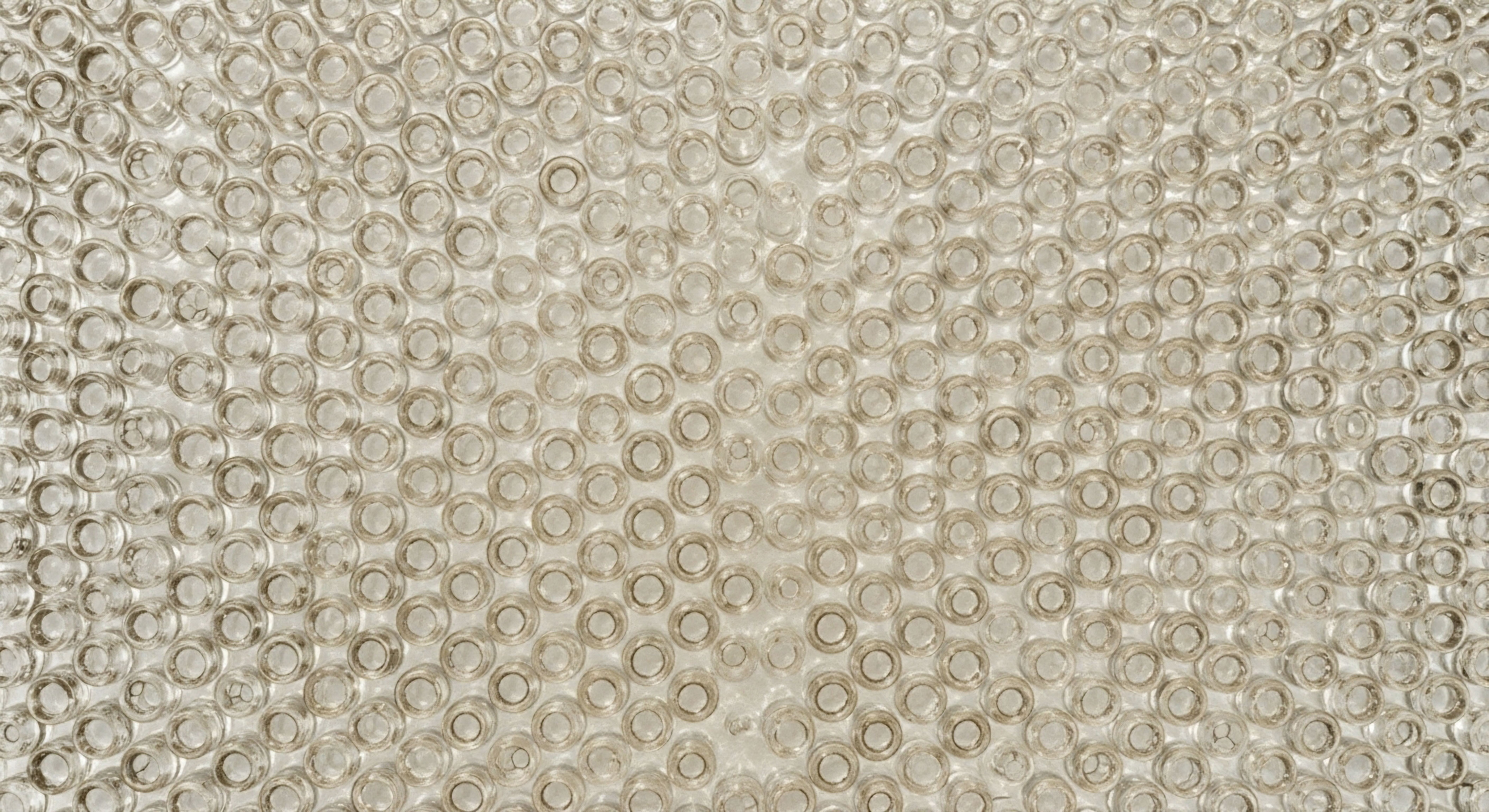

Fundamentals
Your connection to the strength and resilience of your skeleton feels innate, a given. Yet, deep within your bones, a constant, dynamic process of renewal is taking place. This process, known as bone remodeling, is a delicate conversation between cells that break down old bone tissue and cells that build new tissue.
When you feel a shift in your vitality, a change in your physical capacity, it often reflects a change in this internal dialogue. Understanding how pharmacological interventions complement lifestyle for bone preservation begins with appreciating the profound influence of your endocrine system on this very dialogue. Hormones are the body’s primary messengers, and they are the conductors of this intricate skeletal orchestra.
At the heart of bone health is a sophisticated signaling system. The key players in this system are the Receptor Activator of Nuclear Factor Kappa-B Ligand (RANKL), its receptor (RANK), and a protective decoy protein called osteoprotegerin (OPG). Think of RANKL as the signal that authorizes bone breakdown, a necessary step to clear away old, tired bone cells.
OPG, in contrast, acts as a guardian, binding to RANKL and preventing it from giving the green light for excessive breakdown. A healthy skeletal system maintains a precise balance between these two forces. Hormones like estrogen and testosterone are critical in maintaining this equilibrium. They act as master regulators, ensuring the balance tips in favor of preservation and strength.
Hormones such as estrogen and testosterone are essential for maintaining the delicate balance of bone breakdown and formation, a process critical for skeletal health.
When hormonal levels decline, as they do during menopause for women or with age-related testosterone reduction in men, this delicate balance is disrupted. The decline in estrogen, for instance, leads to an increase in RANKL and a decrease in OPG, which accelerates bone resorption.
This shift is not a sign of failure but a predictable biological consequence of a changing internal environment. It is at this juncture that we can begin to understand the complementary roles of lifestyle and pharmacology. Lifestyle choices, such as targeted nutrition and mechanical loading through exercise, provide the raw materials and the physical stimulus for bone formation.
Pharmacological interventions, on the other hand, can directly address the hormonal imbalance, restoring the biochemical signals that protect your bones from within. This dual approach allows for a comprehensive strategy, supporting your body’s innate capacity for renewal while directly addressing the root causes of age-related bone loss.
The journey to preserving bone integrity is a personal one, rooted in the unique biology of your own body. It involves recognizing that symptoms are signals, and those signals point toward underlying systems that can be understood and supported.
By viewing bone health through the lens of endocrinology, we can move beyond a simple focus on calcium and vitamin D, and instead appreciate the complex, interconnected web of hormonal signals that govern skeletal strength. This perspective empowers you to take a proactive role in your health, armed with the knowledge that both your daily choices and targeted clinical support can work in concert to maintain a strong and resilient frame for life.


Intermediate
Building upon the foundational understanding of hormonal influence on bone, we can now examine the specific clinical protocols designed to preserve skeletal integrity. These interventions are designed to work in synergy with lifestyle modifications, creating a powerful, multi-faceted approach to bone health.
Pharmacological strategies are not a replacement for a healthy lifestyle; they are a targeted tool to recalibrate the body’s internal signaling environment, making your efforts in diet and exercise more effective. The goal is to restore the body’s natural state of equilibrium, where bone formation and resorption are in productive balance.

Hormonal Optimization for Bone Preservation
For many individuals, the most direct way to address age-related bone loss is through hormonal optimization protocols. These are not one-size-fits-all solutions but are tailored to the individual’s specific biochemistry, as revealed through comprehensive lab work. The aim is to restore hormonal levels to a range that is protective for bone tissue.

Testosterone Replacement Therapy in Men
In men, declining testosterone levels are a significant contributor to reduced bone mineral density (BMD). Testosterone plays a dual role in bone health ∞ it directly stimulates bone formation and is also converted to estrogen, which powerfully inhibits bone resorption. Testosterone replacement therapy (TRT) in hypogonadal men has been shown to significantly increase BMD, particularly in the spine and hip.
Long-term studies have demonstrated that continuous testosterone therapy can normalize and maintain bone density within a healthy, age-appropriate range. A typical protocol might involve weekly intramuscular injections of Testosterone Cypionate, often accompanied by medications like Gonadorelin to maintain the body’s own testosterone production.

Hormone Therapy in Postmenopausal Women
The loss of estrogen during menopause is the primary driver of accelerated bone loss in women. Hormone replacement therapy (HRT), particularly with estradiol, is a highly effective strategy for preserving bone density and reducing fracture risk. Transdermal estradiol patches are often preferred as they provide consistent hormone delivery.
In many cases, progesterone is also prescribed to protect the uterine lining. Furthermore, low-dose testosterone therapy can be a valuable addition for women, not only for its direct and indirect benefits on bone but also for its positive effects on muscle mass and overall vitality.
Estrogen replacement therapy is a cornerstone for preventing postmenopausal osteoporosis, as it effectively preserves bone mineral density and reduces the incidence of fractures.
The following table illustrates the comparative effects of different hormonal interventions on bone mineral density:
| Intervention | Primary Mechanism of Action | Target Population | Observed Effect on BMD |
|---|---|---|---|
| Testosterone Replacement Therapy (TRT) | Stimulates bone formation; converts to estrogen, inhibiting resorption. | Hypogonadal Men | Significant increase in spinal and hip BMD. |
| Estrogen Replacement Therapy (ERT) | Inhibits bone resorption by suppressing osteoclast activity. | Postmenopausal Women | Preserves BMD and decreases fracture risk. |
| Selective Estrogen Receptor Modulators (SERMs) | Mimics estrogen’s effects on bone while blocking its effects on other tissues. | Postmenopausal Women | Reduces vertebral fracture risk. |

Anabolic Therapies for Significant Bone Loss
For individuals with established osteoporosis or those at very high risk of fracture, anabolic agents offer a powerful therapeutic option. These medications actively build new bone, going beyond simply slowing down bone loss.
- Teriparatide ∞ This medication is a recombinant form of human parathyroid hormone. When administered in intermittent, low doses, it stimulates osteoblasts (bone-building cells) to a greater extent than osteoclasts (bone-resorbing cells), resulting in a net gain of bone mass. Teriparatide has been shown to significantly increase BMD and reduce the risk of both vertebral and non-vertebral fractures.
- Abaloparatide ∞ This is a synthetic analog of parathyroid hormone-related protein (PTHrP). Similar to teriparatide, it has a potent anabolic effect on bone, leading to increased bone formation and improved bone architecture.
- Romosozumab ∞ This is a monoclonal antibody that works through a dual mechanism. It blocks the activity of sclerostin, a protein that inhibits bone formation, while also reducing bone resorption.
These anabolic treatments are typically prescribed for a defined period, usually 12 to 24 months, and are often followed by an anti-resorptive agent, such as a bisphosphonate, to maintain the newly gained bone mass. This sequential approach leverages the bone-building capacity of anabolic agents and then locks in those gains for long-term skeletal health.


Academic
A sophisticated understanding of bone preservation requires a deep appreciation of the molecular signaling pathways that govern skeletal homeostasis. Pharmacological interventions, when viewed through this lens, are revealed as highly specific tools designed to modulate these intricate networks.
The interplay between lifestyle and these interventions is a beautiful example of systems biology in action, where external inputs (nutrition, mechanical stress) and internal modulators (pharmacological agents) converge to influence cellular behavior and tissue-level outcomes. Our focus here will be on the Growth Hormone/Insulin-like Growth Factor-1 (GH/IGF-1) axis, a critical system that links metabolic status with bone anabolism and offers therapeutic targets beyond traditional hormonal replacement.

The GH/IGF-1 Axis a Master Regulator of Bone Anabolism
The GH/IGF-1 axis is a cornerstone of skeletal development and maintenance. Growth hormone, secreted by the pituitary gland, exerts its effects on bone both directly and indirectly. Directly, GH can stimulate osteoblast proliferation and differentiation. Indirectly, and perhaps more powerfully, GH stimulates the liver and other tissues, including bone itself, to produce IGF-1.
This locally produced (autocrine/paracrine) IGF-1 is a potent stimulator of bone formation, enhancing the function of osteoblasts and promoting the synthesis of bone matrix proteins. The circulating (endocrine) IGF-1 also plays a role, though its effects are modulated by a family of IGF-binding proteins (IGFBPs) that regulate its bioavailability.
Deficiencies in the GH/IGF-1 axis, which can occur with aging, contribute to an uncoupling of bone remodeling, where resorption outpaces formation, leading to a net loss of bone mass. This provides a clear rationale for interventions that can restore the anabolic signaling of this pathway.
The GH/IGF-1 axis is a critical regulator of bone formation, with deficiencies in this system contributing to the development of osteoporosis.

Peptide Therapies Targeting the GH/IGF-1 Axis
Peptide therapies represent a more nuanced approach to stimulating the GH/IGF-1 axis compared to direct administration of recombinant human growth hormone (rhGH). These peptides are secretagogues, meaning they stimulate the body’s own production and release of GH from the pituitary gland. This approach can result in a more physiological, pulsatile release of GH, which may improve efficacy and safety profiles.
The following table details some of the key peptides used in this context:
| Peptide | Mechanism of Action | Clinical Application in Bone Health |
|---|---|---|
| Sermorelin | A GHRH analog that stimulates the pituitary to release GH. | Increases endogenous GH levels, leading to higher IGF-1 and stimulation of bone turnover. |
| Ipamorelin / CJC-1295 | Ipamorelin is a GHRP that stimulates GH release; CJC-1295 is a GHRH analog with a longer half-life. The combination provides a sustained and synergistic increase in GH. | Promotes a robust increase in GH and IGF-1, which can enhance bone mineral density over time. |
| Tesamorelin | A stabilized GHRH analog that has been shown to increase IGF-1 levels. | Enhances bone metabolism and has been studied for its effects on bone density in various populations. |

What Is the Clinical Evidence Supporting Peptide Therapy for Bone Health?
Clinical studies investigating the effects of GH and IGF-1 on bone have consistently shown that these hormones increase markers of both bone formation and bone resorption, indicating a stimulation of overall bone turnover. The net effect, however, is anabolic, leading to an increase in bone mineral density over the long term.
The administration of rhIGF-1 has been shown to significantly increase bone formation in clinical studies of osteoporosis. Peptide therapies that increase endogenous GH and, consequently, IGF-1, are expected to produce similar benefits. For instance, research has demonstrated a positive correlation between serum IGF-1 levels and bone mineral density.
The use of these peptides in a clinical setting is often part of a broader strategy for health optimization and longevity. By enhancing the anabolic environment of the body, these therapies can complement the effects of resistance training and adequate protein intake, both of which are powerful stimuli for bone and muscle growth.
The increase in muscle mass and strength that often accompanies these therapies provides an additional, indirect benefit for bone health by reducing the risk of falls and fractures.

How Do These Advanced Therapies Integrate with Lifestyle Strategies?
The integration of advanced pharmacological interventions like peptide therapy with foundational lifestyle strategies creates a powerful synergy. Mechanical loading from resistance exercise is a primary stimulus for osteocyte activity and bone formation. Peptide therapies can amplify the body’s response to this stimulus by ensuring that the necessary anabolic signals (GH and IGF-1) are present.
Similarly, adequate intake of protein, calcium, and vitamin D provides the essential building blocks for new bone tissue. The enhanced anabolic state created by these therapies can improve the efficiency with which the body utilizes these nutrients.
- Mechanical Loading ∞ Resistance exercise sends signals to bone cells to increase their density and strength. Peptide therapies enhance the anabolic hormonal response to this stimulus.
- Nutritional Support ∞ A diet rich in protein, vitamins, and minerals provides the raw materials for bone synthesis. An optimized GH/IGF-1 axis ensures these materials are used effectively.
- Systemic Health ∞ By improving muscle mass, reducing adiposity, and enhancing overall metabolic function, these integrated strategies reduce systemic inflammation, which is itself a contributor to bone loss.
This systems-biology approach, which considers the interplay between hormonal signaling, mechanical forces, and nutritional status, represents the future of personalized wellness and bone preservation. It moves beyond a single-minded focus on one aspect of health and instead embraces the interconnectedness of the body’s systems to achieve a state of optimal function and resilience.

References
- Behling, K. G. & Behling, E. (2014). Hormone replacement therapy and the prevention of postmenopausal osteoporosis. Clinical Cases in Mineral and Bone Metabolism, 11 (2), 110 ∞ 114.
- Jilka, R. L. (2013). The relevance of RANKL/RANK/OPG in bone modeling and remodeling. Journal of Musculoskeletal and Neuronal Interactions, 13 (3), 263 ∞ 270.
- Canalis, E. Giustina, A. & Bilezikian, J. P. (2007). Mechanisms of anabolic therapies for osteoporosis. New England Journal of Medicine, 357 (9), 905 ∞ 916.
- Snyder, P. J. Bhasin, S. Cunningham, G. R. Matsumoto, A. M. Stephens-Shields, A. J. Cauley, J. A. & Testosterone Trials Investigators. (2018). Lessons from the testosterone trials. Endocrine reviews, 39 (3), 369-386.
- Yakar, S. & Isaksson, O. (2016). Regulation of bone growth by the GH/IGF-1 axis. Hormone Research in Paediatrics, 85 (5), 289-296.
- Boonen, S. van der Schee, E. de Vroey, E. & Vanderschueren, D. (2006). The role of testosterone and other sex steroids in the pathogenesis of osteoporosis in men. Current opinion in rheumatology, 18 (4), 411-416.
- Gambacciani, M. & Levancini, M. (2014). Hormone replacement therapy and the prevention of postmenopausal osteoporosis. Przeglad menopauzalny = Menopause review, 13 (4), 213 ∞ 220.
- Giustina, A. Mazziotti, G. & Canalis, E. (2008). Growth hormone, insulin-like growth factors, and the skeleton. Endocrine reviews, 29 (5), 535-559.
- Khosla, S. & Hofbauer, L. C. (2017). Osteoporosis treatment ∞ recent developments and ongoing challenges. The Lancet Diabetes & Endocrinology, 5 (11), 898-907.
- Anawalt, B. D. & Yeap, B. B. (2018). Testosterone and the aging male ∞ to treat or not to treat. The Medical Clinics of North America, 102 (3), 437-450.

Reflection
You have now journeyed through the intricate biological landscape that governs the strength of your bones. This knowledge is more than just a collection of scientific facts; it is a new lens through which to view your own body and its potential.
The dialogue between your cells, the messages carried by your hormones, and the signals sent by your lifestyle choices are all part of a dynamic, interconnected system. Understanding these connections is the first, most crucial step toward taking an active, informed role in your own health narrative.

Where Do You Go from Here?
Consider the information you have absorbed. Does it change how you perceive the subtle shifts in your own body? Does it open up new questions about your personal health trajectory? The path to preserving vitality and function is unique to each individual.
It is a path paved with self-awareness and guided by a deep understanding of your own unique biochemistry. The information presented here is a map, but you are the explorer. Your personal health journey, with its specific symptoms, goals, and biological markers, will determine the route you take.
The ultimate goal is to move forward with confidence, knowing that you have the power to support your body’s innate resilience and to seek out personalized strategies that will allow you to function at your full potential, without compromise.



